Canadian Armed Forces ranks and insignia
This is a table of the ranks and insignia of the Canadian Armed Forces. As the Canadian Armed Forces is officially bilingual, the French language ranks are presented following the English (in italics).
Commander-in-Chief insignia
The Queen of Canada, normally represented by the Governor General, is the Commander-in-Chief of the Canadian Armed Forces, (French: Commandant en chef des Forces armées canadiennes)[1][2] who, in that capacity, may wear a Canadian Armed Forces uniform of any of the three elements.[3][4] The rank insignia is a special sleeve braid embellished with the crest of the Royal arms of Canada and this same embroidered crest is worn on the shoulder straps.
| NATO Code | Special | |
|---|---|---|
.svg.png) |
.svg.png) | |
.svg.png) |
.svg.png) | |
.svg.png) |
.svg.png) | |
Commissioned Member rank insignia
| NATO code | OF-10 | OF-9 | OF-8 | OF-7 | OF-6 | OF-5 | OF-4 | OF-3 | OF-2 | OF-1 | OF(D) | Student officer | ||||||||||||||||||||||||
|---|---|---|---|---|---|---|---|---|---|---|---|---|---|---|---|---|---|---|---|---|---|---|---|---|---|---|---|---|---|---|---|---|---|---|---|---|
(Edit) |
No equivalent |  |
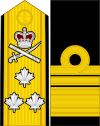 |
 |
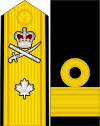 |
 |
 |
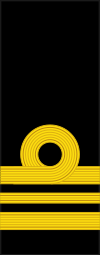 |
 |
 |
 |
.svg.png) |
No equivalent | |||||||||||||||||||||||
| Admiral | Vice-admiral | Rear-admiral | Commodore | Captain | Commander | Lieutenant-commander | Lieutenant | Sub-lieutenant | Acting sub-lieutenant | Naval cadet | ||||||||||||||||||||||||||
| Amiral | Vice-amiral | Contre-amiral | Commodore | Capitaine de vaisseau | Capitaine de frégate | Capitaine de corvette | Lieutenant de vaisseau | Enseigne de vaisseau de 1re classe | Enseigne de vaisseau de 2e classe | Aspirant de marine | ||||||||||||||||||||||||||
(Edit) |
No equivalent |  |
 |
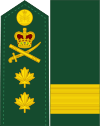 |
 |
 |
 |
 |
 |
 |
 |
.svg.png) |
No equivalent | |||||||||||||||||||||||
| General | Lieutenant-General | Major-General | Brigadier-General | Colonel | Lieutenant-Colonel | Major | Captain | Lieutenant | Second Lieutenant | Officer cadet | ||||||||||||||||||||||||||
| Général | Lieutenant-général | Major-général | Brigadier-général | Colonel | Lieutenant-colonel | Major | Capitaine | Lieutenant | Sous-lieutenant | Élève-officier | ||||||||||||||||||||||||||
(Edit) |
No equivalent | 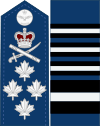 |
 |
 |
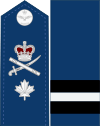 |
 |
 |
 |
 |
 |
 |
.svg.png) |
No equivalent | |||||||||||||||||||||||
| General | Lieutenant General | Major-general | Brigadier-general | Colonel | Lieutenant Colonel | Major | Captain | Lieutenant | Second Lieutenant | Officer Cadet | ||||||||||||||||||||||||||
| Général | Lieutenant-général | Major-général | Brigadier-général | Colonel | Lieutenant-colonel | Major | Capitaine | Lieutenant | Sous-lieutenant | Élève-officier | ||||||||||||||||||||||||||
| NATO code | OF-10 | OF-9 | OF-8 | OF-7 | OF-6 | OF-5 | OF-4 | OF-3 | OF-2 | OF-1 | OF(D) | Student officer | ||||||||||||||||||||||||
Non-commissioned Member (NCM) rank insignia
NCM rank insignia for the rank of Petty Officer 1st class/Warrant Officer and above are worn on the lower sleeve, while those for the rank of Petty Officer 2nd class/Sergeant and below are worn on the upper sleeve.
| NATO Code | OR-9 | OR-8 | OR-7 | OR-6 | OR-5 | OR-4 | OR-3 | OR-2 | OR-1 | |||||||||||||||||||||||||||
|---|---|---|---|---|---|---|---|---|---|---|---|---|---|---|---|---|---|---|---|---|---|---|---|---|---|---|---|---|---|---|---|---|---|---|---|---|
(Edit) |
 |
 |
 |
 |
 |
 |
 |
 |
 | |||||||||||||||||||||||||||
| Chief Petty Officer 1st Class Premier maître de 1re classe |
Chief Petty Officer 2nd Class Premier maître de 2e classe |
Petty Officer 1st Class Maître de 1re classe |
Petty Officer 2nd Class Maître de 2e classe |
Master Seaman Matelot-chef |
Leading Seaman Matelot de 1re classe |
Able Seaman Matelot de 2e classe |
Ordinary Seaman (Basic) Matelot de 3e classe (Confirmé) |
Ordinary Seaman (Recruit) Matelot de 3e classe (Recrue) | ||||||||||||||||||||||||||||
(Edit) |
 |
 |
 |
 |
 |
 |
 |
 |
 | |||||||||||||||||||||||||||
| Chief Warrant Officer Adjudant-chef |
Master Warrant Officer Adjudant-maître |
Warrant Officer Adjudant |
Sergeant Sergent |
Master Corporal Caporal-chef |
Corporal Caporal |
Private (Trained) Soldat (Formé) |
Private (Basic) Soldat (Confirmé) |
Private (Recruit) Soldat (Recrue) | ||||||||||||||||||||||||||||
(Edit) |
 |
 |
 |
 |
 |
 |
 |
 |
 | |||||||||||||||||||||||||||
| Chief Warrant Officer | Master Warrant Officer | Warrant Officer | Sergeant | Master Corporal | Corporal | Aviator (Trained) | Aviator (Basic) | Aviator (Recruit) | ||||||||||||||||||||||||||||
| Adjudant-chef | Adjudant-maître | Adjudant | Sergent | Caporal-chef | Caporal | Aviateur (Formé) | Aviateur (Confirmé) | Aviateur (Recrue) | ||||||||||||||||||||||||||||
| NATO Code | OR-9 | OR-8 | OR-7 | OR-6 | OR-5 | OR-4 | OR-3 | OR-2 | OR-1 | |||||||||||||||||||||||||||
Senior Appointments
| NATO Code | OR-9 | ||
|---|---|---|---|
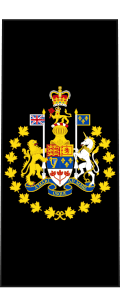 |
 |
 | |
| Canadian Forces Chief Warrant Officer |
Command Chief Petty Officer 1st class |
Senior Appointment Chief Petty Officer 1st class | |
| Adjudant-chef des Forces canadiennes |
Premier Maître de 1re classe du Commandement |
Premier maître de 1re classe | |
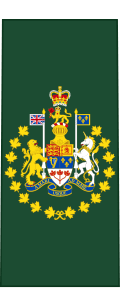 |
 |
 | |
| Canadian Forces Chief Warrant Officer |
Command Chief Warrant Officer | Senior Appointment Chief Warrant Officer | |
| Adjudant-chef des Forces canadiennes |
Adjudant-chef du Commandement |
Adjudant-chef- nomination supérieure | |
 |
 |
 | |
| Canadian Forces Chief Warrant Officer |
Command Chief Warrant Officer | Senior Appointment Chief Warrant Officer | |
| Adjudant-chef des Forces canadiennes |
Adjudant-chef du Commandement |
Adjudant-chef- nomination supérieure | |
Rank slip-ons
The tables above describe the rank insignia worn on the service dress jacket. On DEU shirts, sweaters, and outerwear; and operational dress shirts and jackets, rank insignia are worn on slip-ons with the word "CANADA" or a regimental/branch title embroidered underneath. Flag/general officers' slip-ons include only the crown, crossed sabre and baton, and maple leaves worn on the shoulder straps; they do not include the braid worn on the sleeve. Army NCM slip-ons for DEU shirts, sweaters, and outerwear display only the word "CANADA" or a regimental/branch title, rank insignia being worn instead as enamelled metal pins on collar points or lapels.
Service stripes
From 1955 to 1968 Militia personnel were permitted to wear service insignia on the right jacket sleeve.[5][6] There were one to five silver chevrons on drab backing for every two years of service or a maple leaf in silver thread on a drab cloth circle to represent 10 years of service. Chevron points were worn either up or down; even official documents and photos were confused on the matter. Further awards after 10 years were believed covered by the Canadian Forces Decoration, which was awarded after 12 years and a clasp added for every 10 years afterwards.
Qualifying service could include prior active service in the active reserves of the Royal Canadian Navy and Royal Canadian Air Force or the regular or territorial forces of a fellow Commonwealth member nations. Service in Canadian Army reserve forces units (like the regular reserve, supplementary reserve and reserve militia) did not count. The awarding of Service Stripes ceased in 1968 after the unification of the Canadian Armed Forces.
Distinctive rank names
Some branches and regiments use distinctive rank names in place of master corporal, corporal and private:
| Branch | Master corporal | Corporal | Private |
|---|---|---|---|
| Royal Canadian Armoured Corps | Master corporal (caporal-chef) | Corporal (caporal) | Trooper (cavalier) |
| Royal Regiment of Canadian Artillery | Master bombardier (bombardier-chef) | Bombardier (bombardier) | Gunner (artilleur) |
| Corps of Royal Canadian Engineers | Master corporal (caporal-chef) | Corporal (caporal) | Sapper (sapeur) |
| Royal Canadian Corps of Signals | Master corporal (caporal-chef) | Corporal (caporal) | Signaller (signaleur) |
| Corps of Royal Canadian Electrical and Mechanical Engineers | Master corporal (caporal-chef) | Corporal (caporal) | Craftsman (artisan) |
| Royal Canadian Infantry Corps (RCIC) members of guards regiments | Master corporal (caporal-chef) | Corporal (caporal) | Guardsman (garde) |
| RCIC members of rifle regiments | Master corporal (caporal-chef) | Corporal (caporal) | Rifleman (carabinier) |
| RCIC members of fusilier regiments | Master corporal (caporal-chef) | Corporal (caporal) | Fusilier (fusilier) |
In the guard regiments, warrant officers are known as "colour sergeants" and second lieutenants are known as "ensigns".

Except for those who acquired the Canadian Forces mess dress after 1968 to 2010, naval officers have always worn the Royal Navy-style executive curl rank insignia on mess uniforms (see Royal Navy officer rank insignia). The colour designations for specialist officers are not used except for naval medical officers who may use a variant of the standard rank slip-ons and shoulder boards incorporating a scarlet red background between the gold braid of their rank insignia and naval medical service officers (nursing officers, pharmacy officers, health care administration officers, social work officers, physiotherapy officers, and bioscience officers) who have shoulder boards incorporating a dull cherry red background between the strips of their rank.
Reinstatement of Royal Canadian Navy rank and insignia
When the Canadian Navy was established in 1910 it was natural to adopt the same straight rings with the executive curl for the permanent navy that was designated as the Royal Canadian Navy (RCN) in August 1911 and subsequently the "wavy" shaped rings for the Royal Canadian Naval Volunteer Reserve (RCNVR) and the rings of narrow interwoven gold lace for the Royal Canadian Navy Reserve (RCNR). Other variations in rank insignia included sky blue lace with a diamond shaped loop for officers of the Women's Royal Canadian Naval Service, and warranted Royal Canadian Sea Cadet Corps officers, who had a small anchor in place of the executive curl.
Following the Second World War, the Royal Canadian Navy was reorganized with a single reserve component. In 1946 the distinctive wavy gold braid of the reserves gave way to the straight braided executive curl of the regular force until 1968. With the integration of the Canadian Forces the sea element was designated as Canadian Forces Maritime Command. Unembellished straight braid became the common rank insignia for officers of both the regular and reserve forces. The executive curl rank insignia has been in continuous use in the Royal Canadian Navy, but from 1968 to 2010 it appeared only on navy mess dress.
On 5 March 2010, the Canadian House of Commons passed a motion (moved by Guy Lauzon[7]) recommending the executive curl be reinstated on the Canadian navy uniform. Subsequently, in recognition of the Canadian Naval centennial, Peter MacKay, Minister of National Defence, authorized the use of the executive curl for the Canadian Navy on 2 May 2010. The insignia became effective on 11 June 2010, on the occasion of the Pacific Canadian Naval International Fleet Review parade of nations in Victoria, B.C.[8][9]
More than 54 countries including Canada and 18 other of the 22 Commonwealth navies use the insignia. Most navies that do not use the executive curl insignia substitute a star or other national device above the top row of lace such as the United States Navy and the French Navy.
Timeline of changes (sleeves only)
| NATO code | OF-10 | OF-9 | OF-8 | OF-7 | OF-6 | OF-5 | OF-4 | OF-3 | OF-2 | OF-1 | OF(D) | Student officer | ||||||||||||||||||||||||
|---|---|---|---|---|---|---|---|---|---|---|---|---|---|---|---|---|---|---|---|---|---|---|---|---|---|---|---|---|---|---|---|---|---|---|---|---|
| Maritime Command (1968 - 2010) |
No Equivalent | .svg.png) |
.svg.png) |
.svg.png) |
.svg.png) |
_OF-5.svg.png) |
_OF-4.svg.png) |
_OF-3.svg.png) |
_OF-2.svg.png) |
_OF-1b.svg.png) |
_OF-1a.svg.png) |
No Equivalent | _OF_(D).svg.png) | |||||||||||||||||||||||
| Royal Canadian Navy (Present) |
 |
 |
 |
 |
 |
 |
 |
 |
 |
 |
.svg.png) | |||||||||||||||||||||||||
| Rank titles | Admiral | Vice-admiral | Rear-admiral | Commodore | Captain(N) | Commander | Lieutenant-commander | Lieutenant(N) | Sub-lieutenant | Acting sub-lieutenant | Naval cadet | |||||||||||||||||||||||||
| Amiral | Vice-amiral | Contre-amiral | Commodore | Capitaine de vaisseau | Capitaine de frégate | Capitaine de corvette | Lieutenant de vaisseau | Enseigne de vaisseau de 1re classe | Enseigne de vaisseau de 2e classe | Aspirant de marine | ||||||||||||||||||||||||||
Reinstatement of Canadian Army ranks and insignia
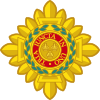 |
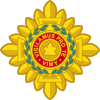 |
| On the centenary of the Battle of Vimy Ridge (9 April 2017), the Bath Star was replaced by the "Vimy Star". It depicts a maple leaf and is surrounded by the Latin motto vigilamus pro te ("we stand on guard for thee"). |
The Minister of National Defence, Peter MacKay, announced on 8 July 2013 their intention to restore the traditional rank names for all Canadian Army non-commissioned members, as well as the reintroduction of Canadian Army officers' rank insignia.[10] Instead of the navy-style rank insignia, Canadian Army officers once again use the traditional St Edward's Crown and Star of the Order of the Bath insignia, commonly called "pips and crowns", a system which is more than one hundred years old.[11] The traditional gorget patches were also restored for officers of the rank of colonel or higher.[12] The re-introduction of Canadian Army rank insignia was expected to save the Canadian Armed Forces $53,550 per year, but with an initial outlay of $245,000, savings are not expected to be realized until after the first five years.[13] The reasons behind the return to the traditional Canadian Army ranks and insignia were explained by the minister of national defence as strengthening Canadian Army identity as "our officers who accepted the (German) surrender, were wearing pips and Crowns. This in no way diminishes Canada's identity, and I would suggest we are returning to the insignia that was so much a part of what the Canadian Army accomplished in Canada's name".[14] The reinstated insignia for officers, instead of using the current British rank insignia for brigadier (used in the Canadian Army until 1968), had the pre-1920 brigadier-general insignia (crossed sabre and baton) instead.
Supported by a new Liberal government, on April 2, 2016, the Commander of the Canadian Army announced that the army was abandoning the traditional rank insignia for general officers announced in 2013 and instituted in 2014 and that general officers would revert to the unification-era rank insignia worn between 1968 and 2013. This rank insignia is based on the shoulder board rank insignia of Royal Canadian Navy flag officers, which in turn is derived from the shoulder board rank insignia of Royal Navy flag officers. The rank insignia of general officers now consists of a crown, crossed sabre and baton, and a series of maple leaves on shoulder straps along with one broad naval-style gold band on each of the lower sleeves of the service dress tunic.[15] World War 2 colours backing were also reinstated in order to represent the arm of service for officers on their cloth slip-ons.[16]
Commissioned officers of the household guard regiments (Governor General's Foot Guards, Canadian Grenadier Guards, and Governor General's Horse Guards), plus Army personnel stationed to the seasional Ceremonial Guard, use the Guards Star in place of the Vimy Star on their shoulder boards.
| Unit | Colour | |
|---|---|---|
| Flag Officers
Generals Logistic Branch Military Police Branch Public Affairs Branch Royal Regiment of Canadian Artillery |
Red |  |
| The Corps of Royal Canadian Engineers
The Royal Canadian Corps of Signals Royal Canadian Electrical and Mechanical Engineers |
Blue | 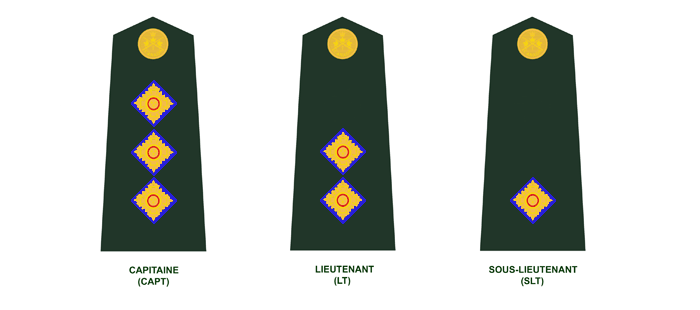 |
| Infantry units (except Rifle Regiments) | Scarlet | 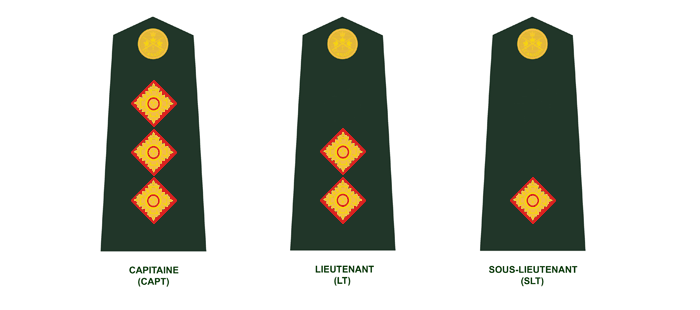 |
| Royal Canadian Armoured Corps | Cavalry gold | 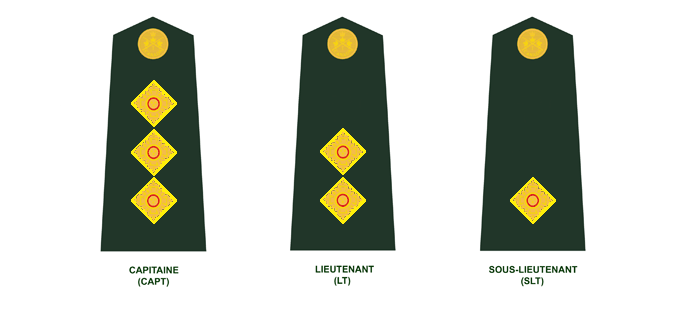 |
| Royal Canadian Medical Service | Dull cherry | 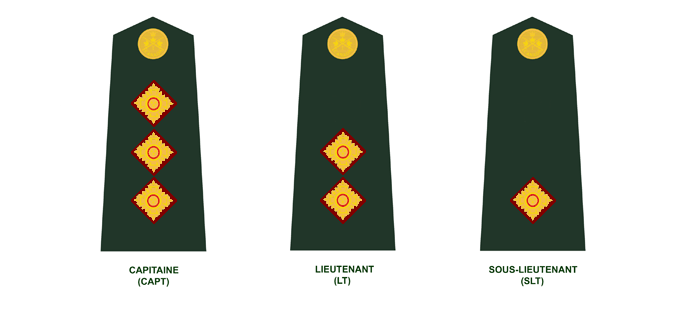 |
| Royal Canadian Dental Corps | Emerald Green | 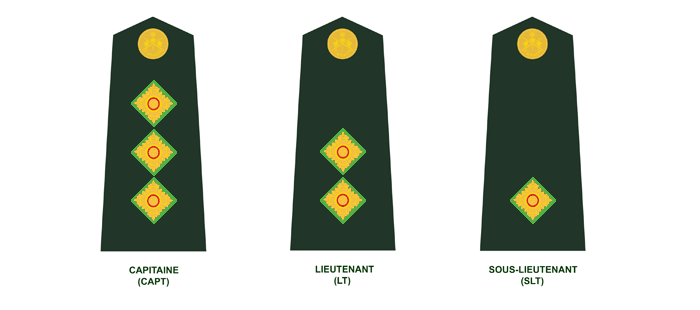 |
| Intelligence Branch | Silver |  |
| Royal Canadian Chaplain Service | Purple | 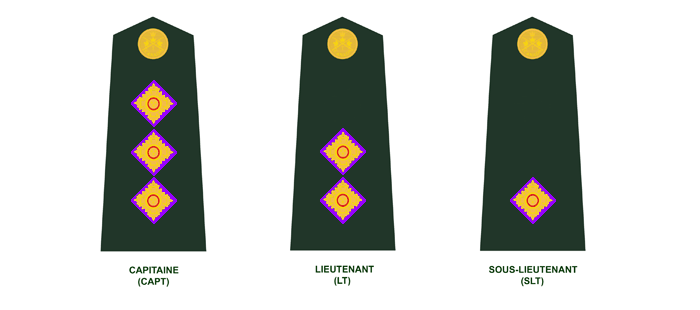 |
Timeline of changes
| NATO Code | OF-10 | OF-9 | OF-8 | OF-7 | OF-6 | OF-5 | OF-4 | OF-3 | OF-2 | OF-1 | OF(D) | Student Officer | |
|---|---|---|---|---|---|---|---|---|---|---|---|---|---|
| Mobile Command & Land Force Command (1968 - 2013) |
No Equivalent |  |
 |
 |
 |
_OF-5.svg.png) |
_OF-4.svg.png) |
_OF-3.svg.png) |
_OF-2.svg.png) |
_OF-1b.svg.png) |
_OF-1a.svg.png) |
No Equivalent | _OF_(D).svg.png) |
| Canadian Army (2013 - 2016) |
_OF-9.svg.png) |
_OF-8.svg.png) |
_OF-7.svg.png) |
_OF-6.svg.png) |
.svg.png) |
.svg.png) |
 |
.svg.png) |
.svg.png) |
.svg.png) |
_(2016-2017).svg.png) | ||
| Canadian Army (2016-2017) |
 |
 |
 |
 |
.svg.png) |
.svg.png) |
 |
.svg.png) |
.svg.png) |
.svg.png) |
_(2016-2017).svg.png) | ||
| Canadian Army (Present) |
 |
 |
 |
 |
 |
 |
 |
 |
 |
 |
.svg.png) | ||
| Rank titles | General | Lieutenant-General | Major-General | Brigadier-General | Colonel | Lieutenant-Colonel | Major | Captain | Lieutenant | Second Lieutenant | Officer Cadet | ||
| Général | Lieutenant-général | Major-général | Brigadier-général | Colonel | Lieutenant-colonel | Major | Capitaine | Lieutenant | Sous-lieutenant | Élève-officier | |||
Reinstatement of Royal Canadian Air Force rank and insignia
In April 2015,[17] the Royal Canadian Air Force adopted new rank insignia reminiscent of the pre-unification RCAF system. The new officer rank insignia uses pearl-grey-on-black rank stripes instead of gold. Non-commissioned members (NCMs) rank insignia is pearl grey instead of gold. The colour gold found elsewhere on the uniform was also changed to pearl-grey. The air force rank of private, formerly indicated by one chevron, became aviator (Fr: aviateur), and is indicated by a horizontally-aligned two-bladed propeller. All other ranks titles remain as they were.[18]
Timeline of changes
| NATO code | OF-10 | OF-9 | OF-8 | OF-7 | OF-6 | OF-5 | OF-4 | OF-3 | OF-2 | OF-1 | OF(D) | Student officer | ||||||||||||||||||||||||
|---|---|---|---|---|---|---|---|---|---|---|---|---|---|---|---|---|---|---|---|---|---|---|---|---|---|---|---|---|---|---|---|---|---|---|---|---|
| Air Command (1968 - 2010) |
No Equivalent | _OF-9.svg.png) |
_OF-8.svg.png) |
_OF-7.svg.png) |
_OF-6.svg.png) |
_OF-5.svg.png) |
_OF-4.svg.png) |
_OF-3.svg.png) |
_OF-2.svg.png) |
_OF-1b.svg.png) |
_OF-1a.svg.png) |
No Equivalent | _OF_(D).svg.png) | |||||||||||||||||||||||
| Royal Canadian Air Force (Present) |
_OF-9.svg.png) |
_OF-8.svg.png) |
_OF-7.svg.png) |
_OF-6.svg.png) |
 |
 |
 |
 |
 |
 |
.svg.png) | |||||||||||||||||||||||||
| Rank titles | General | Lieutenant General | Major-general | Brigadier-general | Colonel | Lieutenant Colonel | Major | Captain | Lieutenant | Second lieutenant |
Officer Cadet | |||||||||||||||||||||||||
| Général | Lieutenant-général | Major-général | Brigadier-général | Colonel | Lieutenant-colonel | Major | Capitaine | Lieutenant | Sous-lieutenant | Élève-Officier | ||||||||||||||||||||||||||
See also
References
- ↑ Lagassé, Philippe (December 2013). "The Crown's Powers of Command-in Chief: Interpreting Section 15 of Canada's Constitution Act, 1867" (PDF). Review of Constitutional Studies. 18 (2): 189–220.
- ↑ Federal Court of Canada (21 January 2008), In the Matter of Aralt Mac Giolla Chainnigh v. the Attorney-General of Canada (PDF), T-1809-06; 38, Ottawa: Queen's Printer for Canada, p. 5, 2008 FC 69, retrieved 7 February 2008
- ↑ Canadian Forces Dress Instructions. Her Majesty the Queen in Right of Canada. 1995. pp. 3-1–1.
- ↑ Office of the Secretary to the Governor General. "Commander-in-Chief". Her Majesty the Queen in Right of Canada. Retrieved 8 November 2015.
- ↑ Service Stripes
- ↑ Grimshaw, Lou. Military Collector's Club of Canada Journal (Spring 1997 issue)
- ↑ "Guy Lauzon on Canadian Navy". Hansard. 5 March 2010. Retrieved 10 January 2011.
- ↑ Marotte. B. (May. 03, 2010). "Navy celebrates centennial by restoring historic insignia." The Globe and Mail. Retrieved on: 20 June 2010.
- ↑ National Defence Canada. Photo of the day archive. Retrieved on: 20 June 2010.
- ↑ "Canada restores historical features of the Canadian Army". Department of National Defence. 8 July 2013. Retrieved 25 July 2013.
- ↑ "Restoring the Canadian Army's historical identity". The Department of National Defence. 8 July 2013. Retrieved 25 July 2013.
- ↑ Pugliese, David (8 July 2013). "Government Intends To Restore Canadian Army Rank Insignia, Names and Badges To Their Traditional Forms". The Ottawa Citizen. Retrieved 25 July 2013.
- ↑ Pugliese, David (21 July 2013). "New Canadian Army insignias to pay for themselves, military says". The Ottawa Citizen. Retrieved 25 July 2013.
- ↑ Brewster, Murray (8 July 2013). "Canadian Army goes back to the future with return to British-style ranks and designations". The Toronto Star. Retrieved 25 July 2013.
- ↑ "Canadian Army Announces Changes to the General Officer Rank Insignia". Department of National Defence. April 2, 2016. Retrieved 15 December 2017.
- ↑ "Rank and Appointment Insignia". The Canadian soldier in the 20th Century.
- ↑ Pugliese, David (24 September 2014). "New RCAF Insignia and rank colours not available until March 2015". Ottawa Citizen. Retrieved 24 September 2014.
- ↑ unknown (21 September 2014). "New Uniform for the Royal Canadian Air Force". Government of Canada. Retrieved 24 September 2014.
External links
- Canadian Armed Forces ranks and appointment insignia – official site with images of rank insignia for Navy, Army and Air Force.